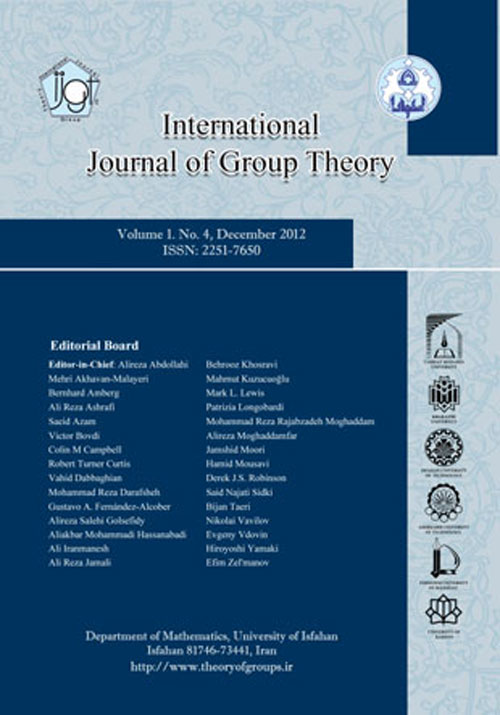فهرست مطالب

International Journal of Group Theory
Volume:5 Issue: 1, Mar 2016
- تاریخ انتشار: 1394/11/20
- تعداد عناوین: 5
-
-
Pages 1-10Suppose Gamma Gamma is a graph with V(Gamma)=1,2,cdots,p V(Gamma)=1,2,cdots,p and mathcalF=Gamma 1 ,cdots,Gamma p mathcalF=Gamma1,cdots,Gammap is a family of graphs such that n j =|V(Gamma j )| nj=|V(Gammaj)| , 1leqjleqp 1leqjleqp . Define Lambda=Gamma[Gamma 1 ,cdots,Gamma p ] Lambda=Gamma[Gamma1,cdots,Gammap] to be a graph with vertex set V(Lambda)=bigcup p j=1 V(Gamma j ) V(Lambda)=bigcupj=1pV(Gammaj) and edge set E(Lambda)=big(bigcup p j=1 E(Gamma j )big)cupbig(bigcup ijinE(Gamma) uv;uin (Gamma i ),vinV(Gamma j )big) E(Lambda)=big(bigcupj=1pE(Gammaj)big)cupbig(bigcupijinE(Gamma)uv;uin (Gammai),vinV(Gammaj)big) . The graph Lambda Lambda is called the Gamma− Gamma− join of mathcalF mathcalF .The power graph mathcalP(G) mathcalP(G) of a group G G is the graph which has the group elements as vertex set and two elements are adjacent if one is a power of the other. The aim of this paper isto prove mathcalP(mathbbZ n )=K phi(n) n [K phi(d 1 ) ,K phi(d 2 ) ,cdots,K phi(d p ) ] mathcalP(mathbbZn)=Kphi(n)ퟠ�횧[Kphi(d1),Kphi(d2),cdots,Kphi(dp)] , where Delta n Deltan is a graph with vertex and edge sets V(Delta n )=d i |1,nnot=d i |n,1leqileqp V(Deltan)=di|1,nnot=di|n,1leqileqp and $ E(Delta_n)={ d_id_j | d_i|d_j, 1leq iKeywords: Power graph, generalized join, Automorphism group
-
Pages 11-16In this paperý, ýwe determine the simple groups G=AB G=AB ý, ýwhere B B is isomorphic to L 3 (4) L3(4) and A A isomorphic to an alternating or a symmetric group on ngeq5 ngeq5 ý, ýlettersý.Keywords: Factorization, product of groups, symmetric groups
-
Pages 17-28Let G G be a finite group and pi e (G) pie(G) be the set of element orders of G G . Let kinpi e (G) kinpie(G) and s k sk be the number of elements of order k k in G G . Set nse(G G ):=s k |kinpi e (G) sk|kinpie(G) . In this paper, it is proved if |G|=| |G|=| PGL 2 (q)| 2(q)| , where q q is odd prime power and nse(G)= (G)= nse( ( PGL 2 (q)) 2(q)) , then Gcong Gcong PGL$_
-
Pages 29-35Let pi e (G) pie(G) be the set of element orders of a finite group G G ý. ýLet nse(G)=m n midninpi e (G) nse(G)=mnmidninpie(G) ý, ýwhere m n mn be the number of elements of order n n in G G ý. ýIn this paperý, ýwe prove that if nse(G)=nse(L 2 (81)) nse(G)=nse(L2(81)) ý, ýthen GcongL 2 (81) GcongL2(81)ý.Keywords: ýSet of the numbers of elements of the same orderý, ýorder of an elementý, ýThompson's problem
-
Pages 37-51We examine the symplectic group Sp 2m (q) Sp2m(q) and its corresponding affine subgroup. We construct the affine subgroup and show that it is a split extension. As an illustration of the above we study the affine subgroup 2 5 :Sp 4 (2) 25:Sp4(2) of the group Sp 6 (2) Sp6(2).Keywords: Group extensions, character table, symplectic groups

